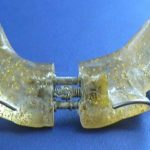Say Goodbye To The White Stuff On Hibiscus Leaves With These Action-Packed Tips!
Understanding White Stuff on Hibiscus Leaves: Causes, Effects, and Solutions
Greetings, Smart Peoples! In this article, we will discuss the common issue of white stuff appearing on hibiscus leaves. Hibiscus plants are known for their vibrant and beautiful flowers, but when white substances start to appear on their leaves, it can be a cause for concern. In this comprehensive guide, we will explore the reasons behind this phenomenon, its impact on the plant’s health, and effective solutions to combat it.
The White Stuff on Hibiscus Leaves: What is it?
The white stuff that often appears on hibiscus leaves is a fungal infection known as powdery mildew. It is caused by various species of fungi that thrive in warm and humid environments. Powdery mildew presents as a powdery white or gray substance on the upper surfaces of the leaves, stems, and buds of the hibiscus plant.
1 Picture Gallery: Say Goodbye To The White Stuff On Hibiscus Leaves With These Action-Packed Tips!

How does Powdery Mildew Develop?
Powdery mildew develops when spores from the fungi land on the hibiscus plant’s leaves and the environmental conditions are favorable for their growth. These conditions include high humidity, warm temperatures, poor air circulation, and overcrowding of plants. The spores germinate and form a network of thread-like structures called hyphae, which then spread across the leaf surface, causing the characteristic white powdery appearance.
Who is Affected by Powdery Mildew?
Powdery mildew can affect hibiscus plants of all varieties, including both tropical and hardy hibiscus. It is particularly common in areas with warm climates and high humidity, but it can occur anywhere, especially during the summer months. Young and newly planted hibiscus plants are more susceptible to powdery mildew, as their immune systems have not fully developed.
When Does Powdery Mildew Occur?

Image Source: walterreeves.com
Powdery mildew is most prevalent during periods of warm and humid weather, typically in the late spring and summer months. However, it can also occur in cooler temperatures if the humidity levels are high. The disease can spread rapidly, especially when the conditions are ideal for its growth. Regular monitoring of hibiscus plants is essential to catch and treat powdery mildew early.
Where Does Powdery Mildew Thrive?
Powdery mildew thrives in environments with high humidity and poor air circulation. It can occur both outdoors and indoors, affecting hibiscus plants in gardens, landscapes, and even potted plants. Overcrowding of plants, excessive shade, and lack of proper air movement can create the ideal conditions for the fungi to multiply and spread.
Why is Powdery Mildew Harmful to Hibiscus Plants?
Powdery mildew can cause significant damage to hibiscus plants if left untreated. The fungal infection weakens the leaves, reducing their ability to photosynthesize and produce energy. As a result, the plant’s growth and overall health are compromised. Severe infestations can lead to leaf drop, stunted growth, deformed flowers, and even death of the plant in extreme cases.
How to Prevent and Control Powdery Mildew on Hibiscus Plants?
Prevention and control of powdery mildew on hibiscus plants involve a combination of cultural practices and fungicidal treatments. Here are some effective strategies:
1️⃣ Ensure proper spacing between hibiscus plants to promote air circulation.
2️⃣ Avoid overhead watering, as wet foliage provides a favorable environment for powdery mildew to thrive.
3️⃣ Remove and destroy any infected plant parts, including leaves and buds, to prevent the spread of spores.
4️⃣ Apply fungicides specifically formulated to combat powdery mildew on hibiscus plants. Follow the instructions carefully and apply as recommended.
5️⃣ Regularly monitor your hibiscus plants for signs of powdery mildew and take immediate action at the first sight of infection.
6️⃣ Prune hibiscus plants to improve air circulation and sunlight penetration, reducing the likelihood of powdery mildew development.
7️⃣ Choose hibiscus varieties that are resistant to powdery mildew, if available.
Pros and Cons of Dealing with Powdery Mildew on Hibiscus Plants
Advantages:
1. Early detection and treatment of powdery mildew can save hibiscus plants from severe damage and potential death.
2. Implementing preventive measures reduces the risk of powdery mildew infestation and the need for intensive treatment later on.
3. Proper care and management of hibiscus plants result in healthier and more vibrant blooms.
4. Controlling powdery mildew promotes overall plant health and longevity.
5. Successfully combating powdery mildew on hibiscus plants can enhance your gardening skills and knowledge.
Disadvantages:
1. Powdery mildew can be challenging to completely eradicate, particularly in severe cases.
2. Some fungicides may have negative effects on beneficial insects and other organisms in the ecosystem.
3. Continuous monitoring and treatment may be necessary, requiring time and effort.
4. Severe powdery mildew infections may cause irreversible damage to hibiscus plants, leading to their demise.
5. The cost of preventive measures and fungicides can accumulate over time.
Frequently Asked Questions (FAQs)
Q1: Can powdery mildew on hibiscus plants spread to other plants nearby?
A1: Yes, powdery mildew can spread to other plants in close proximity. It is crucial to promptly isolate and treat infected hibiscus plants to prevent the disease from spreading further.
Q2: Can powdery mildew be harmful to humans?
A2: While powdery mildew does not typically harm humans directly, it can cause respiratory issues in individuals with compromised immune systems or allergies. Avoid direct contact with infected hibiscus plants and take necessary precautions when handling them.
Q3: Are there any natural remedies to control powdery mildew on hibiscus plants?
A3: Yes, several natural remedies can help control powdery mildew, including neem oil, baking soda solution, and milk spray. However, their effectiveness may vary, and it is important to follow proper application methods.
Q4: Can powdery mildew affect indoor hibiscus plants?
A4: Yes, powdery mildew can affect indoor hibiscus plants if the environmental conditions are favorable for its growth. Proper air circulation and humidity control are essential in preventing powdery mildew indoors.
Q5: Can powdery mildew on hibiscus plants be prevented through cultural practices alone?
A5: While cultural practices such as proper spacing, pruning, and watering can significantly reduce the risk of powdery mildew, they may not guarantee complete prevention. Fungicidal treatments may still be necessary, especially in high-risk areas or during severe outbreaks.
Conclusion
In conclusion, the presence of white stuff on hibiscus leaves, known as powdery mildew, is a common fungal infection that can affect the health and aesthetics of these beautiful plants. However, with proper prevention and timely treatment, hibiscus enthusiasts can successfully manage and control powdery mildew, ensuring the vitality and longevity of their plants. Remember to monitor your hibiscus plants regularly, implement cultural practices to promote a healthy environment, and seek professional advice if needed. Happy gardening!
Final Remarks
Disclaimer: The information provided in this article is for educational purposes only and should not be considered as professional advice. The management and treatment of powdery mildew on hibiscus plants may vary depending on specific circumstances. Consult with a horticulturist or plant care specialist for personalized recommendations and solutions.
This post topic: Stuff


